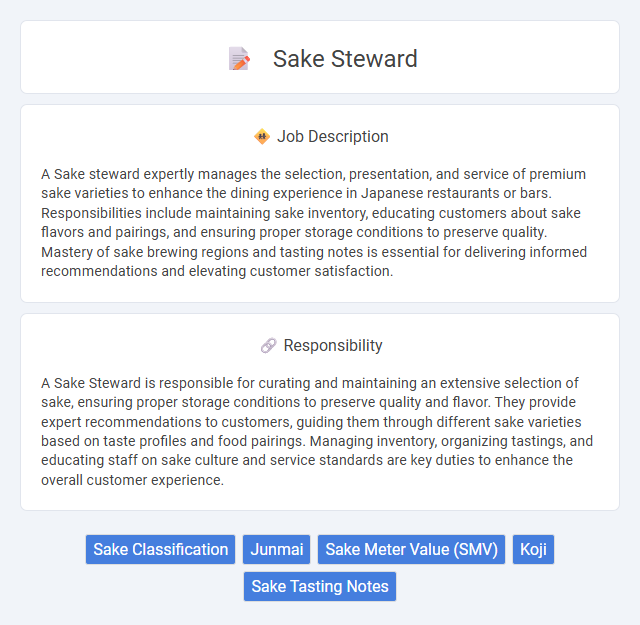
A Sake steward expertly manages the selection, presentation, and service of premium sake varieties to enhance the dining experience in Japanese restaurants or bars. Responsibilities include maintaining sake inventory, educating customers about sake flavors and pairings, and ensuring proper storage conditions to preserve quality. Mastery of sake brewing regions and tasting notes is essential for delivering informed recommendations and elevating customer satisfaction.
Individuals with strong attention to detail and a passion for Japanese culture will likely find the role of a Sake steward suitable. Those who enjoy engaging with customers and have good communication skills may be well-suited to managing sake tastings and providing knowledgeable recommendations. Candidates who prefer fast-paced environments and have a willingness to continuously learn about sake varieties could probably excel in this position.
Qualification
Sake steward positions require extensive knowledge of Japanese rice wine varieties, production methods, and proper serving techniques. Candidates must possess excellent sensory skills for tasting and pairing sake with food, alongside strong communication abilities to educate customers. Formal certification from recognized institutions, such as the Sake Service Institute, significantly enhances job qualification.
Responsibility
A Sake Steward is responsible for curating and maintaining an extensive selection of sake, ensuring proper storage conditions to preserve quality and flavor. They provide expert recommendations to customers, guiding them through different sake varieties based on taste profiles and food pairings. Managing inventory, organizing tastings, and educating staff on sake culture and service standards are key duties to enhance the overall customer experience.
Benefit
Sake steward roles likely offer unique cultural immersion and specialized knowledge in traditional Japanese beverages, enhancing expertise in sake varieties and pairing techniques. This position may provide opportunities for professional growth within hospitality or culinary sectors, potentially increasing career prospects. Employees might also enjoy networking with industry professionals, expanding connections that could benefit future endeavors.
Challenge
The role of a Sake steward likely involves the challenge of mastering a wide range of sake varieties and understanding their unique brewing processes to provide expert recommendations. Balancing customer preferences with authentic pairings may require continuous learning and adaptability in a fast-paced environment. The responsibility to preserve sake's cultural significance while enhancing the dining experience suggests a complex yet rewarding professional challenge.
Career Advancement
A Sake steward specializes in the selection, storage, and serving of sake, gaining expertise in Japanese rice wine varieties and brewing processes. Mastery in sake tasting and pairing cultivates opportunities for advancement into roles such as beverage director, restaurant sommelier, or sake consultant. Continuous education and certifications, such as those from the Sake Service Institute, enhance career growth within high-end dining and hospitality sectors.
Key Terms
Sake Classification
A Sake steward specializes in the classification and selection of various types of sake, including Junmai, Ginjo, Daiginjo, and Honjozo, based on their brewing methods and flavor profiles. Expertise in reading sake labels and understanding the nuances of rice polishing ratios, fermentation processes, and regional characteristics is essential for guiding customers. This role also involves pairing sake with appropriate foods to enhance dining experiences and deepen appreciation of sake varieties.
Junmai
A Sake steward specializing in Junmai expertly manages the selection, storage, and serving of this pure rice sake, ensuring optimal flavor preservation by controlling temperature and humidity. Deep knowledge of Junmai's fermentation process and regional variations enhances customer education and enhances tasting experiences. Mastery in pairing Junmai with appropriate dishes elevates the overall appreciation of this traditional Japanese beverage.
Sake Meter Value (SMV)
A Sake steward expertly manages sake selections, emphasizing the Sake Meter Value (SMV) to guide customers through taste profiles ranging from sweet (-3) to dry (+10). Mastery of SMV allows precise pairing of sake with diverse cuisines, enhancing overall dining experiences. This role demands in-depth knowledge of fermentation processes influencing SMV, ensuring each recommendation matches individual preferences.
Koji
A Sake steward expertly manages Koji, the essential mold (Aspergillus oryzae) used to saccharify rice starch into fermentable sugars during sake production. Deep knowledge of Koji cultivation techniques, including optimal temperature, humidity, and incubation time, ensures high-quality fermentation and distinctive sake flavor profiles. Precise handling and monitoring of Koji promote enzymatic activity, directly impacting sake aroma, umami, and overall quality.
Sake Tasting Notes
A Sake Steward expertly evaluates and documents sake tasting notes, identifying key flavor profiles such as umami, acidity, sweetness, and aroma. They distinguish between various types of sake, including Junmai, Ginjo, and Daiginjo, highlighting characteristics like rice polishing ratio and fermentation techniques. Accurate tasting notes help guide customers in pairing sake with food and enhancing their overall dining experience.
 kuljobs.com
kuljobs.com